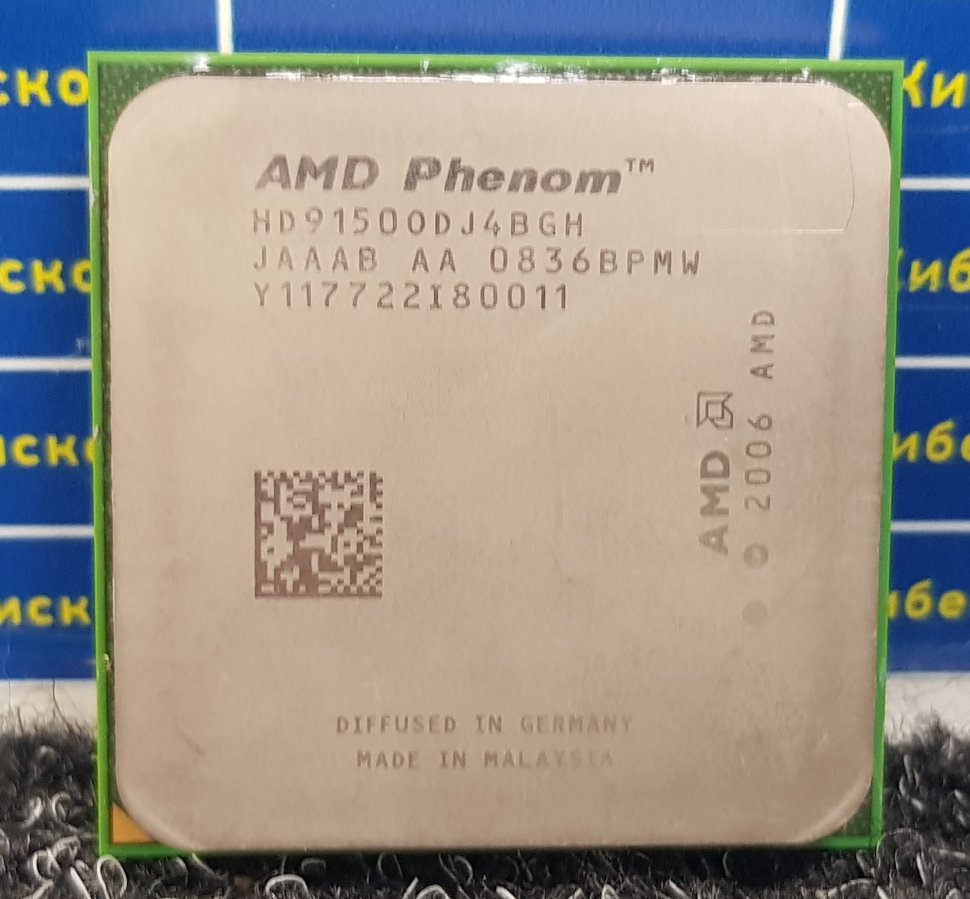AMD Phenom II X4 Processors List
Filter by codename
- Deneb
- Propus
- Zosma
| Name | Cores / Threads | Clock | Socket | L3 Cache | TDP | Released |
|---|---|---|---|---|---|---|
| AMD Phenom II X4 650T Phenom II X4 (Zosma) |
4 / 4 | 2.7 GHz (up to 3.2 GHz) |
AMD Socket AM3 | 4MB (shared) | 95 W | 1 July 2011 |
| AMD Phenom II X4 850 Phenom II X4 (Propus) |
4 / 4 | 3.3 GHz | AMD Socket AM3 | — | 95 W | 1 June 2011 |
| AMD Phenom II X4 980 BE Phenom II X4 (Deneb) |
4 / 4 | 3.7 GHz | AMD Socket AM3 | 6MB (shared) | 125 W | 3 May 2011 |
| AMD Phenom II X4 840 Phenom II X4 (Propus) |
4 / 4 | 3.2 GHz | AMD Socket AM3 | — | 95 W | 4 January 2011 |
| AMD Phenom II X4 975 BE Phenom II X4 (Deneb) |
4 / 4 | 3. |
AMD Socket AM3 | 6MB (shared) | 125 W | 4 January 2011 |
| AMD Phenom II X4 970 BE Phenom II X4 (Zosma) |
4 / 4 | 3.5 GHz | AMD Socket AM3 | 6MB (shared) | 125 W | 1 October 2010 |
| AMD Phenom II X4 970 BE Phenom II X4 (Deneb) |
4 / 4 | 3.5 GHz | AMD Socket AM3 | 6MB (shared) | 125 W | 21 September 2010 |
| AMD Phenom II X4 840T Phenom II X4 (Zosma) |
4 / 4 | 2.9 GHz (up to 3.2 GHz) |
AMD Socket AM3 | 6MB (shared) | 95 W | 1 September 2010 |
| AMD Phenom II X4 960T BE Phenom II X4 (Zosma) |
4 / 4 | 3 GHz (up to 3.4 GHz) |
AMD Socket AM3 | 6MB (shared) | 95 W | 1 June 2010 |
| AMD Phenom II X4 B97 Phenom II X4 (Deneb) |
4 / 4 | 3. 2 GHz 2 GHz |
AMD Socket AM3 | 6MB (shared) | 95 W | 11 May 2010 |
| AMD Phenom II X4 910e Phenom II X4 (Deneb) |
4 / 4 | 2.6 GHz | AMD Socket AM3 | 6MB (shared) | 65 W | 25 January 2010 |
| AMD Phenom II X4 965 BE (125W) Phenom II X4 (Deneb) |
4 / 4 | 3.4 GHz | AMD Socket AM3 | 6MB (shared) | 125 W | 7 November 2009 |
| AMD Phenom II X4 B95 Phenom II X4 (Deneb) |
4 / 4 | 3 GHz | AMD Socket AM3 | 6MB (shared) | 95 W | 1 October 2009 |
| AMD Phenom II X4 B93 Phenom II X4 (Deneb) |
4 / 4 | 2.8 GHz | AMD Socket AM3 | 6MB (shared) | 95 W | 1 October 2009 |
| AMD Phenom II X4 830 Phenom II X4 (Deneb) |
4 / 4 | 2.8 GHz | AMD Socket AM3 | 4MB (shared) | 95 W | 1 September 2009 |
| AMD Phenom II X4 820 Phenom II X4 (Deneb) |
4 / 4 | 2.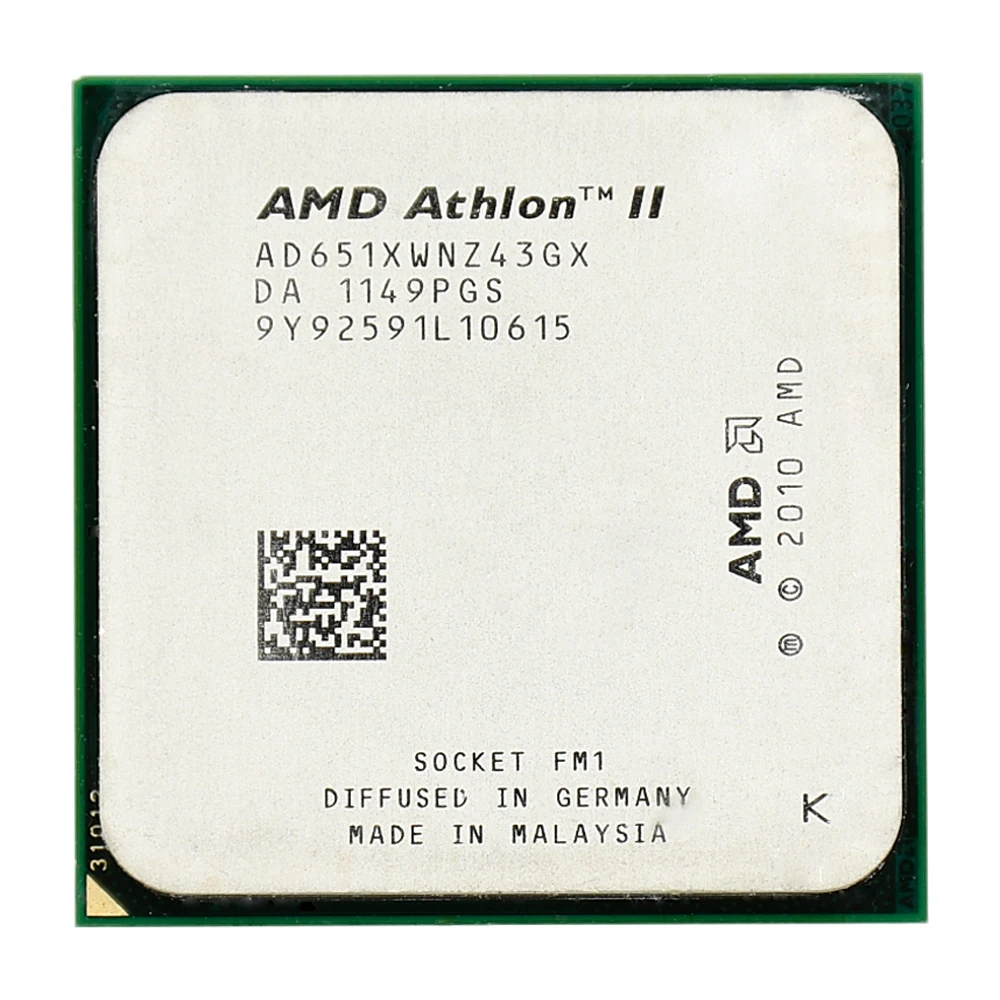 8 GHz 8 GHz |
AMD Socket AM3 | 4MB (shared) | 95 W | 1 September 2009 |
| AMD Phenom II X4 965 BE (140W) Phenom II X4 (Deneb) |
4 / 4 | 3.4 GHz | AMD Socket AM3 | 6MB (shared) | 140 W | 13 August 2009 |
| AMD Phenom II X4 945 (95W) Phenom II X4 (Deneb) |
4 / 4 | 3 GHz | AMD Socket AM3 | 6MB (shared) | 95 W | 22 July 2009 |
| AMD Phenom II X4 900e Phenom II X4 (Deneb) |
4 / 4 | 2.4 GHz | AMD Socket AM3 | 6MB (shared) | 65 W | 2 June 2009 |
| AMD Phenom II X4 905e Phenom II X4 (Deneb) |
4 / 4 | 2.5 GHz | AMD Socket AM3 | 6MB (shared) | 65 W | 2 June 2009 |
| AMD Phenom II 42 TWKR Black Edition Phenom II X4 (Deneb) |
4 / 4 | 2000 MHz | AMD Socket AM3 | 6MB (shared) | 125 W | 1 June 2009 |
| AMD Phenom II X4 925 Phenom II X4 (Deneb) |
4 / 4 | 2.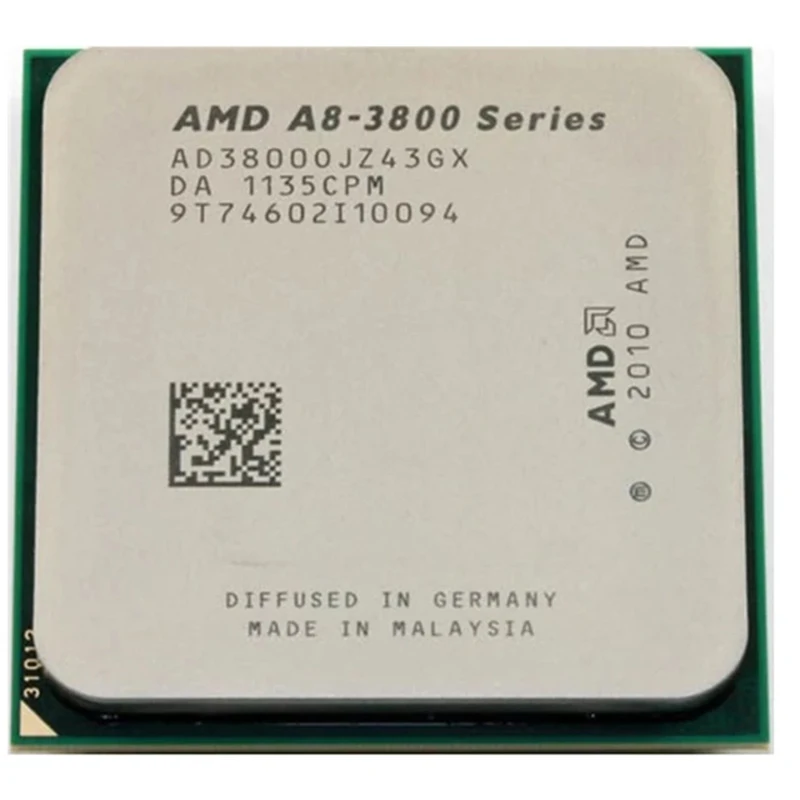 8 GHz 8 GHz |
AMD Socket AM3 | 6MB (shared) | 95 W | 11 May 2009 |
| AMD Phenom II X4 945 (125W) Phenom II X4 (Deneb) |
4 / 4 | 3 GHz | AMD Socket AM3 | 6MB (shared) | 125 W | 23 April 2009 |
| AMD Phenom II X4 955 BE Phenom II X4 (Deneb) |
4 / 4 | 3.2 GHz | AMD Socket AM3 | 6MB (shared) | 125 W | 23 April 2009 |
| AMD Phenom II X4 955 (125W) Phenom II X4 (Deneb) |
4 / 4 | 3.2 GHz | AMD Socket AM3 | 6MB (shared) | 125 W | 1 April 2009 |
| AMD Phenom II X4 955 (95W) Phenom II X4 (Deneb) |
4 / 4 | 3.2 GHz | AMD Socket AM3 | 6MB (shared) | 95 W | 1 April 2009 |
| AMD Phenom II X4 810 Phenom II X4 (Deneb) |
4 / 4 | 2.6 GHz | AMD Socket AM3 | 4MB (shared) | 95 W | 9 February 2009 |
| AMD Phenom II X4 805 Phenom II X4 (Deneb) |
4 / 4 | 2. 5 GHz 5 GHz |
AMD Socket AM3 | 4MB (shared) | 95 W | 9 February 2009 |
| AMD Phenom II X4 910 Phenom II X4 (Deneb) |
4 / 4 | 2.6 GHz | AMD Socket AM3 | 6MB (shared) | 95 W | 9 February 2009 |
| AMD Phenom II X4 940 BE Phenom II X4 (Deneb) |
4 / 4 | 3 GHz | AMD Socket AM3 | 6MB (shared) | 125 W | 8 January 2009 |
| AMD Phenom II X4 920 Phenom II X4 (Deneb) |
4 / 4 | 2.8 GHz | AMD Socket AM3 | 6MB (shared) | 125 W | 8 January 2009 |
Browse by generation
- A10
- A12
- A4
- A6
- A8
- A9
- Athlon
- Athlon 64
- Athlon 64 FX
- Athlon 64 X2
- Athlon II X2
- Athlon II X3
- Athlon II X4
- Athlon Model 4
- Athlon X2
- Athlon XP
- C
- E
- E1
- E2
- EPYC
- EPYC Embedded
- FX
- Mobile Athlon 64
- Mobile Sempron
- Opteron
- Opteron X2
- Phenom II X2
- Phenom II X3
- Phenom II X4
- Phenom II X6
- Phenom X3
- Phenom X4
- Ryzen 3
- Ryzen 5
- Ryzen 7
- Ryzen 9
- Ryzen Embedded
- Ryzen Threadripper
- Sempron
- Sempron X2
- Turion 64
- Turion X2
- Turion X2 Ultra
- Z
Top 8 Best AMD Phenom II CPU Processors in 2023 (Reviews)
Mike Davis
Last Updated: May 24, 2023
AMD Phenom II CPU processors are a popular choice for those seeking a high-performance processor for their desktop system.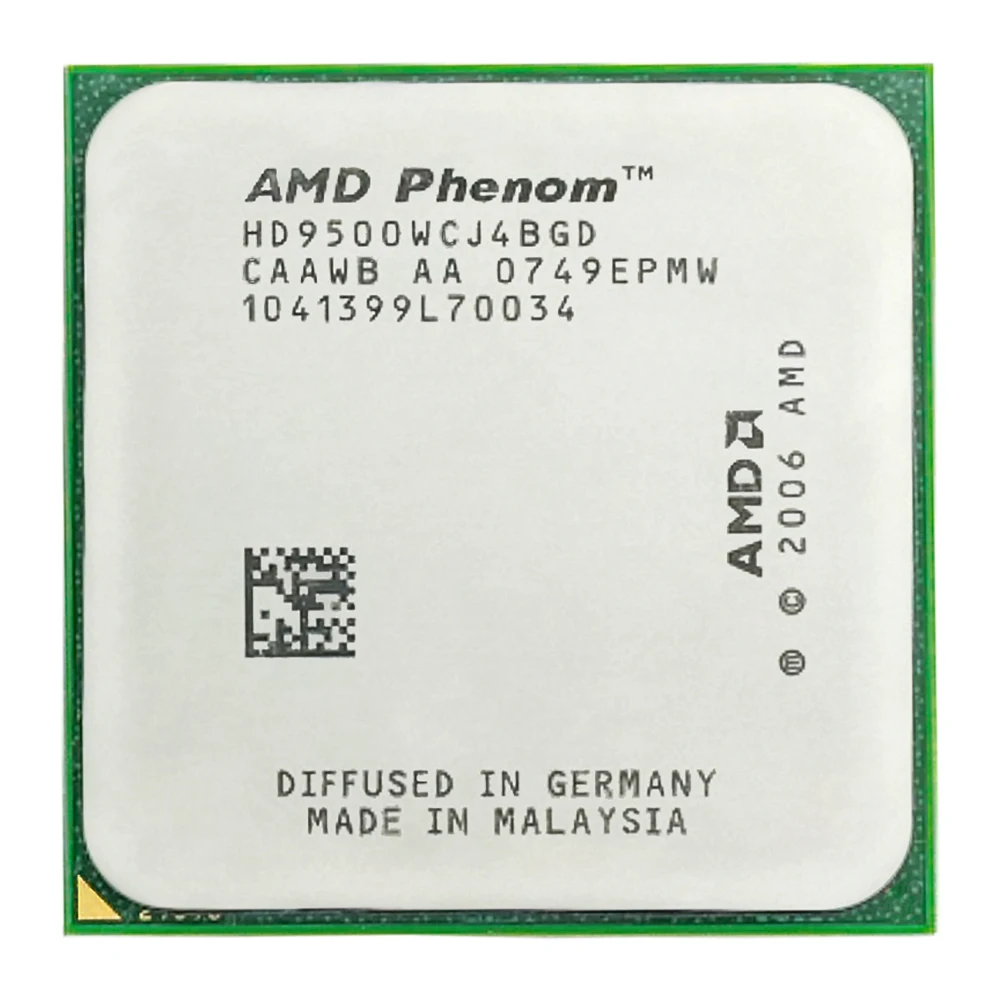 With clock speeds ranging from 2.5 GHz to 3.7 GHz, these processors offer excellent performance for gaming, video editing, and other intensive tasks. They also feature multiple cores, allowing for efficient multitasking and improved system responsiveness. Additionally, AMD Phenom II CPUs are compatible with a wide range of motherboards and offer excellent value for their price point. Overall, these processors are a reliable choice for those seeking a powerful and cost-effective CPU solution.
With clock speeds ranging from 2.5 GHz to 3.7 GHz, these processors offer excellent performance for gaming, video editing, and other intensive tasks. They also feature multiple cores, allowing for efficient multitasking and improved system responsiveness. Additionally, AMD Phenom II CPUs are compatible with a wide range of motherboards and offer excellent value for their price point. Overall, these processors are a reliable choice for those seeking a powerful and cost-effective CPU solution.
* Our editing teams independently research, review, and recommend the best products based on extensive data analysis; if you click on the product links, we may earn a commission from qualifying purchases.
At a Glance: Our Top Picks
#TOP
1
AMD Phenom II X4 965 CPU Processor
9.9
FTB Score
#TOP
3
AMD Phenom II X6 1100T Black Edition CPU Processor
9.6
FTB Score
Top 8 Best AMD Phenom II CPU Processors
AMD
965 125W
6.50 x 3.40 x 1.00 inches
The AMD Phenom II X4 965 CPU Processor is a 64-bit processor with a clock frequency of 3.4GHz and a clock multiplier of 17. It has a bus speed of 667 MHz Memory controller and one 2000 MHz 16-bit HyperTransport link (4 GT/s). This quad-core processor has four threads and a Thermal Design Power of 125 Watt. With L2 cache of 4 x 512 KB and L3 cache of 6MB, the AMD Phenom II X4 965 is a powerful processor that can handle multiple tasks and applications with ease. Its fast clock speed and high cache memory make it suitable for gaming, video editing, and other CPU-intensive tasks.
This quad-core processor has four threads and a Thermal Design Power of 125 Watt. With L2 cache of 4 x 512 KB and L3 cache of 6MB, the AMD Phenom II X4 965 is a powerful processor that can handle multiple tasks and applications with ease. Its fast clock speed and high cache memory make it suitable for gaming, video editing, and other CPU-intensive tasks.
What We Like
Quad-core processor
Can handle games prior to 2020
Good replacement for old motherboard
Can revive aging system
Overclockable for improved performance
AMD
HDZ955FBGMBOX
3.80 x 1.90 x 0.40 inches
1.66 pounds
The AMD Phenom II X4 955 Black Edition CPU Processor is a budget-friendly option that offers multicore processing power. With four 3.2 GHz cores, it can handle even the most highly threaded applications. The processor also features an unlocked multiplier that allows for overclocking, and an ultra-wide bandwidth for quick memory access. It is compatible with motherboards with an AM2+ or AM3 socket, making it easy to transition from older sockets.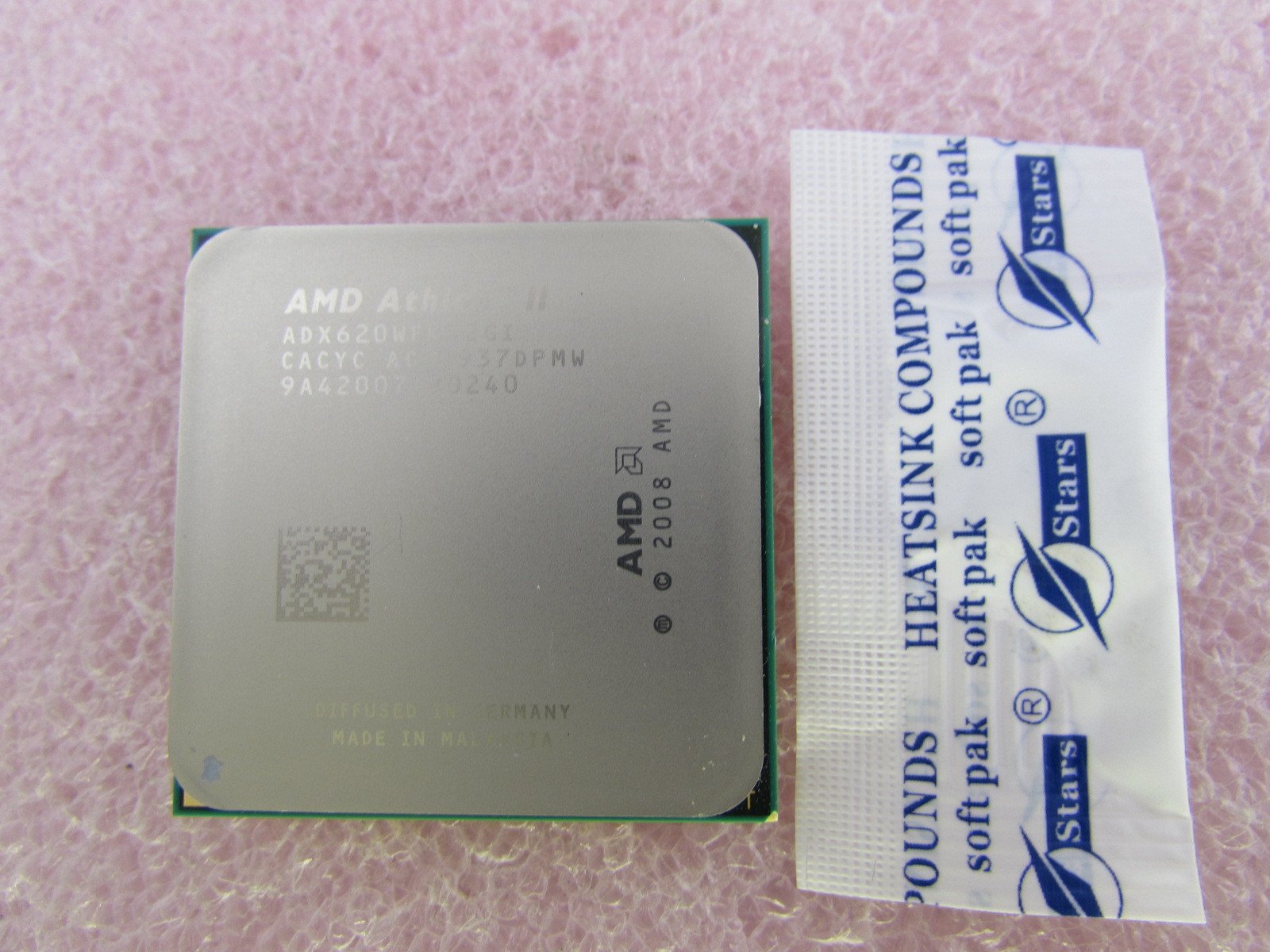 This CPU processor is designed to handle next-gen games and is quiet, cool, and energy efficient.
This CPU processor is designed to handle next-gen games and is quiet, cool, and energy efficient.
What We Like
Four 3.2 GHz cores for blazing-fast processing
Unlocked multiplier offers flexibility for overclocking
Fast, ultra-wide bandwidth for quick memory access
AMD
1100T
The AMD Phenom II X6 Processor is a powerful CPU processor designed for high-speed performance. With a bus speed of 667 MHz memory controller and one 2000 MHz 16-bit HyperTransport link, this processor can handle multiple tasks with ease. It features six cores, each with a 512 KB cache size, providing a total of 3 MB of cache memory. This processor also has a clock multiplier of 16.5, allowing for even faster processing speeds. Overall, the AMD Phenom II X6 Processor is an ideal choice for users looking for a reliable and high-performance CPU processor.
What We Like
High performance
Reliable
Good for power users
Fastest in its family
#TOP 4
AMD Phenom II X4 940 Processor
AMD
HDZ940XCGIBOX
0. 40 x 0.40 x 0.40 inches
40 x 0.40 x 0.40 inches
0.22 pounds
The AMD Phenom II X4 940 Processor is a powerful quad-core processor that has a clock speed of 3.0GHz and 8MB cache memory. It is compatible with Socket AM2+ and has a TDP of 125W. This processor is perfect for users who demand high-performance computing, whether for gaming, content creation, or multitasking. The quad-core design allows for efficient multitasking while the 8MB cache memory ensures faster access to frequently used data. The 3.0GHz clock speed provides fast processing and is ideal for running resource-intensive applications. The Socket AM2+ compatibility ensures easy installation and compatibility with a wide range of motherboards. Overall, the AMD Phenom II X4 940 Processor is a reliable and high-performance processor that offers excellent value for money.
What We Like
Quad-core design
8MB cache memory
3.0GHz clock speed
#TOP 5
AMD Phenom II X4 955 Processor
AMD
HDX955WFK4DGM
The AMD Quad-Core Processor is a high-performance CPU that fits in both AMD socket AM2+ and AM3. It comes with a 6 MB L3 cache and 4 x 512 KB L2 cache, providing fast data access and processing. With a 95 Watt Thermal Design Power, it delivers high energy efficiency and low power consumption. The quad-core design enables you to multitask efficiently, running multiple applications without slowing down your system. The processor is perfect for gamers, content creators, and anyone who needs a powerful CPU.
It comes with a 6 MB L3 cache and 4 x 512 KB L2 cache, providing fast data access and processing. With a 95 Watt Thermal Design Power, it delivers high energy efficiency and low power consumption. The quad-core design enables you to multitask efficiently, running multiple applications without slowing down your system. The processor is perfect for gamers, content creators, and anyone who needs a powerful CPU.
What We Like
High-performance
Low power consumption
Quad-core design
AMD
HDT55TFBK6DGR
The AMD Phenom II X6 1055T Six Core CPU Processor is a powerful and reliable option for those in need of a high-performance CPU. With a frequency of 2.8GHz and 6 cores, this processor is capable of handling even the most demanding tasks. It features a 6MB L3 cache and 6 x 512KB L2 cache, as well as a thermal design power of 125 watts. The processor is fully tested and comes with a 3-month warranty, but it’s important to consult with the seller to ensure compatibility with your motherboard before purchasing.
What We Like
Powerful 6-core processor with a frequency of 2.8GHz
6MB L3 cache and 6 x 512KB L2 cache for efficient performance
Comes with a 3-month warranty and is fully tested
#TOP 7
AMD Phenom II X6 1055T Processor
AMD
HDT55TWFGRBOX
0.34 kilograms
The AMD Phenom II X6 is a CPU processor designed for high definition entertainment, advanced multitasking performance, and energy efficiency. With its native Multi-Core Technology, you can expect a smoother and faster experience, even when running complex software applications. This processor delivers unbeatable multi-core value, making it an excellent choice for users who require high-performance computing. Additionally, the AMD Phenom II X6 comes equipped with power-saving innovations that allow for smaller, cooler machines that are energy-efficient. Overall, this processor is an excellent choice for users who demand exceptional performance and energy efficiency from their computing devices.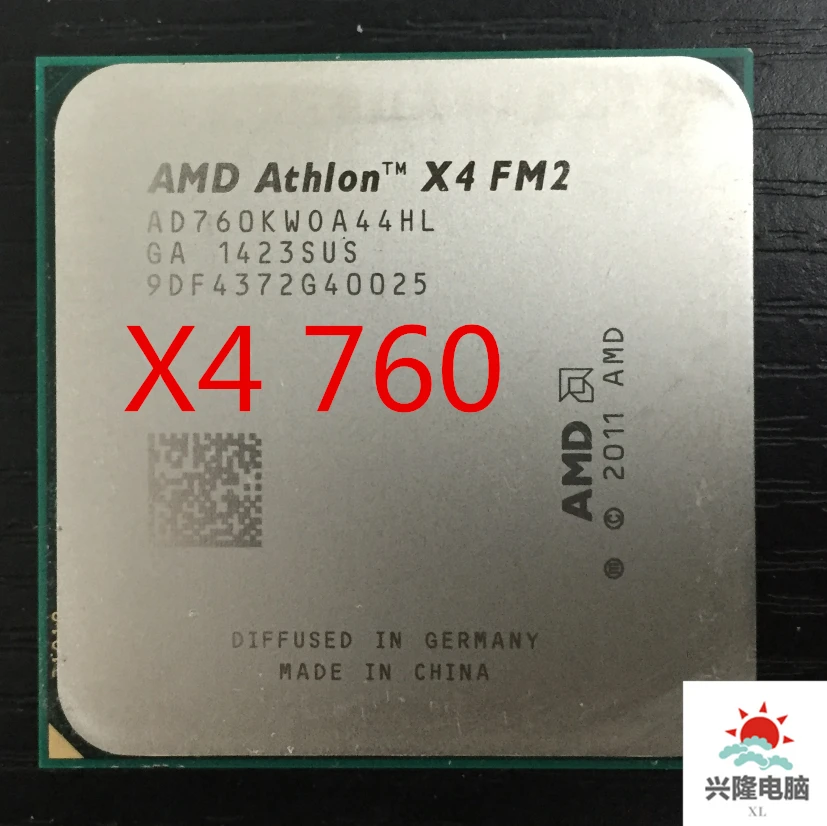
What We Like
Unbeatable multi-core value
The Ultimate Visual Experience
Native Multi-Core Technology
AMD
HDZ955FBK4DGM
The AMD Phenom II X4 955 Black Edition CPU is a powerful quad-core processor that offers a 3.2 GHz core speed, 4 x 512 KB L2 cache, and 6 MB L3 cache. It features an integrated 144-bit DDR2/DDR3 SDRAM memory controller and HyperTransport 3 technology, providing a high-bandwidth interface for the CPU to access your system’s RAM. This CPU is built using a 45 nm fabrication process and features four cores on die, giving you the power of four CPUs in one Socket AM3 package, allowing you to use it with Socket AM3, AM2+ and even AM2 motherboards.
What We Like
Unlocked multiplier for overclocking
Integrated memory controller
Compatible with Socket AM3, AM2+, and AM2 motherboards
Why We Recommend AMD Phenom II CPU Processors
Introduction
When it comes to choosing a CPU processor, there are a lot of options out there. However, if you’re looking for high performance at an affordable price, AMD Phenom II processors are a great choice. In this article, we’ll discuss how to choose the right AMD Phenom II processor for your needs.
However, if you’re looking for high performance at an affordable price, AMD Phenom II processors are a great choice. In this article, we’ll discuss how to choose the right AMD Phenom II processor for your needs.
Understanding the Basics
Before we dive into the specifics, it’s important to understand the basics of CPU processors. A processor is essentially the brain of your computer, responsible for executing instructions and performing calculations. The speed and performance of your processor can have a big impact on your computer’s overall performance.
When it comes to choosing a processor, there are a few key factors to consider. These include clock speed (measured in GHz), the number of cores, and the cache size. Generally speaking, higher numbers in these categories indicate better performance.
Clock Speed
Clock speed refers to the number of cycles per second that a processor can execute. The higher the clock speed, the faster the processor can perform calculations. However, it’s important to note that clock speed isn’t the only factor that affects performance. A processor with multiple cores and a larger cache can also perform better, even if its clock speed is lower.
However, it’s important to note that clock speed isn’t the only factor that affects performance. A processor with multiple cores and a larger cache can also perform better, even if its clock speed is lower.
Cores
A core is essentially a processing unit within a processor. A processor with more cores can execute more instructions simultaneously, which can lead to better performance. For example, a quad-core processor can execute four instructions at once, while a dual-core processor can only execute two.
However, it’s important to note that not all software is optimized to take advantage of multiple cores. In some cases, a processor with fewer cores but a higher clock speed may actually perform better.
Cache Size
The cache is a high-speed memory buffer that stores frequently accessed data. A larger cache can lead to better performance, as the processor can access data more quickly. However, it’s important to note that cache size isn’t the only factor that affects performance.
Choosing the Right Processor
When it comes to choosing the right AMD Phenom II processor, there are a few factors to consider. First, consider your budget. AMD Phenom II processors are generally more affordable than their Intel counterparts, making them a great choice for budget-conscious buyers.
Next, consider your needs. If you’re a gamer or a power user, you’ll likely want a processor with multiple cores and a high clock speed. On the other hand, if you’re simply using your computer for basic tasks like web browsing and word processing, a processor with fewer cores and a lower clock speed may be sufficient.
Finally, consider the specific model of AMD Phenom II processor you’re considering. Each model has different specs in terms of clock speed, number of cores, and cache size. Be sure to read reviews and benchmarks to ensure that the model you choose will meet your needs.
Conclusion
In conclusion, choosing the right AMD Phenom II processor is all about understanding your needs and budget. Consider factors like clock speed, number of cores, and cache size when making your decision, and be sure to read reviews and benchmarks before making a purchase. With the right AMD Phenom II processor, you can enjoy high performance at an affordable price.
Consider factors like clock speed, number of cores, and cache size when making your decision, and be sure to read reviews and benchmarks before making a purchase. With the right AMD Phenom II processor, you can enjoy high performance at an affordable price.
Editor’s Notes
During our amd phenom ii cpu processor research, we found 139 amd phenom ii cpu processor products and shortlisted 8 quality products. We collected and analyzed 5,443 customer reviews through our big data system to write the amd phenom ii cpu processors list. We found that most customers choose amd phenom ii cpu processors with an average price of $90.76.
The amd phenom ii cpu processors are available for purchase. We have researched hundreds of brands and picked the top brands of amd phenom ii cpu processors, including AMD and more. The seller of top 1 product has received honest feedback from 129 consumers with an average rating of 4.6.
Written by
Mike Davis
Mike Davis is a professionally trained electrician with six years of working experience in the electronics industry. He has written an array of web and mobile-based articles for e-magazines and blogs. He loves trying out some novel and popular gadgets and his expertise is in the areas of electronics and computers which is built over many years of working and personal experiences.
He has written an array of web and mobile-based articles for e-magazines and blogs. He loves trying out some novel and popular gadgets and his expertise is in the areas of electronics and computers which is built over many years of working and personal experiences.
AMD Phenom and Phenom II x2, x3, x4, x6 Processors: Complete List
Phenom and Phenom II are AMD’s line of 64-bit desktop processors. The processors in this line are based on the K10 architecture, which AMD refers to as the 10h processor family. In this article, we will talk about the Phenom processor line, as well as provide a complete list of processors that have been released since the existence of this line.
Table of Contents
Phenom 9 at a Glance0007
The Phenom line appeared in 2007 and existed until 2011. The first Phenom processors were released for socket AM2+, later Phenom II appeared, which were released mainly for AM3 and AM3+.
When the first four core models of this line were released, AMD emphasized that only these processors can be considered truly quad-core, since then the Intel Core 2 Quad series is a multi-chip assembly, and in the case of Phenom, all four cores are on a single silicon chip .
The initial launch of the Phenom processors was not without noticeable problems. Just before the release of these processors, a serious bug was discovered in them, which could potentially lead to a system lock. To resolve this issue, a BIOS update was released that programmatically disabled the failed module. But, such a solution led to a decrease in performance by 10% or more. And due to the fact that this BIOS did not appear immediately, buyers received slower processors than those provided to the specialized media before the release. In later releases of Phenom processors (beginning with the B3 stepping), this error was fixed by hardware.
The early Phenom processor architecture included a 128-bit DDR2 memory controller at up to 1066 MHz (DDR3 support will be implemented later), 128 KB L1 cache per core, 512 KB L2 cache per core core, as well as a 2 MB L3 cache common to all cores.
One of the important features of this architecture was the emergence of new technologies to save energy. For example, Cool’n’Quiet 2.0 technology allows you to reduce the supply voltage, the clock frequency of the entire processor, as well as the clock frequency of individual cores, AMD CoolCore technology allows you to disable inactive core modules, and Dual Dynamic Power Management technology allows you to set different voltages for different processor cores and memory controller.
For example, Cool’n’Quiet 2.0 technology allows you to reduce the supply voltage, the clock frequency of the entire processor, as well as the clock frequency of individual cores, AMD CoolCore technology allows you to disable inactive core modules, and Dual Dynamic Power Management technology allows you to set different voltages for different processor cores and memory controller.
Phenom X3 processors
| Stepping | Frequency | L2 cache | L3 cache | Hyper Transport Frequency | HT base frequency multiplier | Voltage | TDP | Socket | |
| AMD Phenom X3 8250e | B3 | 1.9 GHz | 3x 512 KB | 2 MB | 1.6 GHz | 9.5x | 1.125 — 1.20 | 65W | AM2+ |
| AMD Phenom X3 8400 | B2 | 2.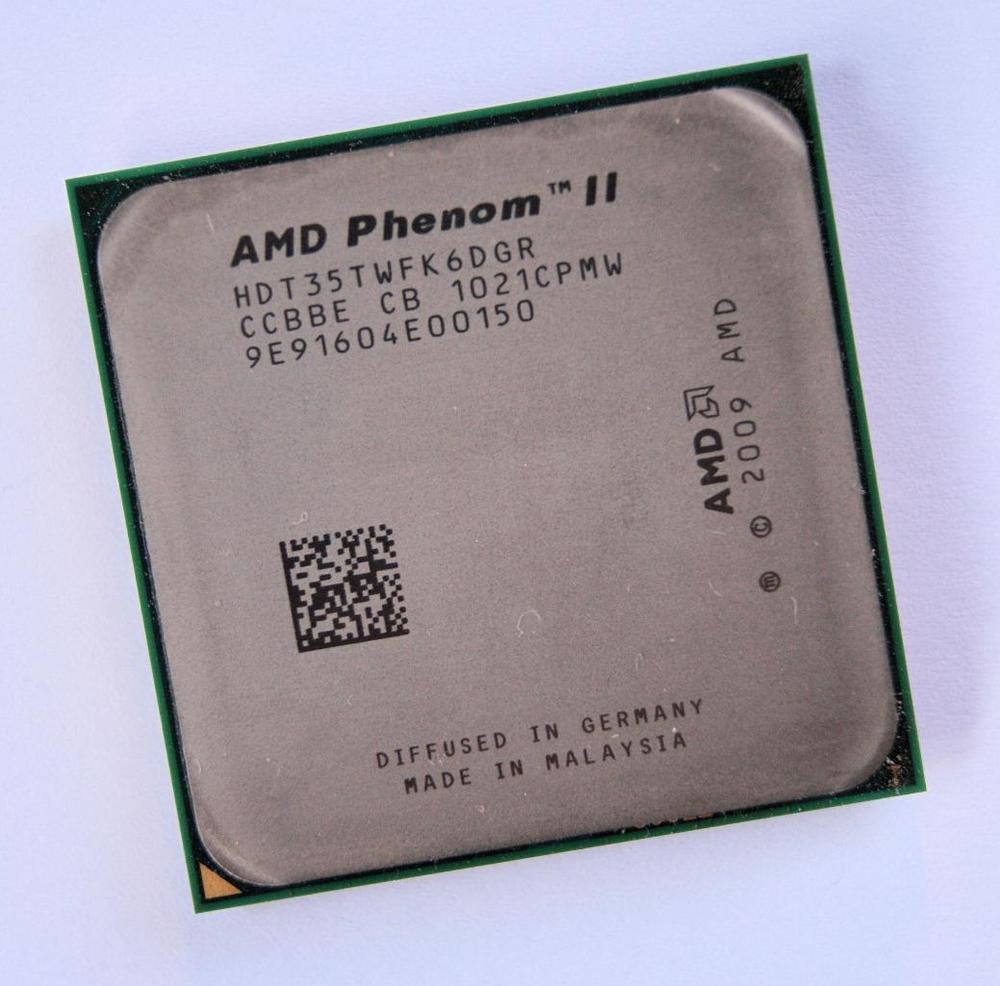 1GHz 1GHz |
3x 512 KB | 2 MB | 1.8 GHz | 10.5x | 1.20 — 1.25 | 95W | AM2+ |
| AMD Phenom X3 8450 | B3 | 2.1GHz | 3x 512 KB | 2 MB | 1.8 GHz | 10.5x | 1.20 — 1.25 | 95W | AM2+ |
| AMD Phenom X3 8450e | B3 | 2.1GHz | 3x 512 KB | 2 MB | 1.8 GHz | 10.5x | 1.125 — 1.20 | 65 W | AM2+ |
| AMD Phenom X3 8550 | B3 | 2.2 GHz | 3x 512 KB | 2 MB | 1.8 GHz | 11x | 1.20 — 1.25 | 95W | AM2+ |
| AMD Phenom X3 8600 | B2 | 2.3GHz | 3x 512 KB | 2 MB | 1.8 GHz | 11.5x | 1.20 — 1.25 | 95W | AM2+ |
| AMD Phenom X3 8650 | B3 | 2. 3GHz 3GHz |
3x 512 KB | 2 MB | 1.8 GHz | 11.5x | 1.20 — 1.25 | 95W | AM2+ |
| AMD Phenom X3 8750 | B3 | 2.4 GHz | 3x 512 KB | 2 MB | 1.8 GHz | 12x | 1.20 — 1.25 | 95W | AM2+ |
| AMD Phenom X3 8750 Black Edition | B3 | 2.4 GHz | 3x 512 KB | 2 MB | 1.8 GHz | 12x | 1.20 — 1.25 | 95 W | AM2+ |
| AMD Phenom X3 8850 | B3 | 2.5 GHz | 3x 512 KB | 2 MB | 1.8 GHz | 12.5x | 1.20 — 1.25 | 95W | AM2+ |
Phenom X4 processors
 8 GHz
8 GHz 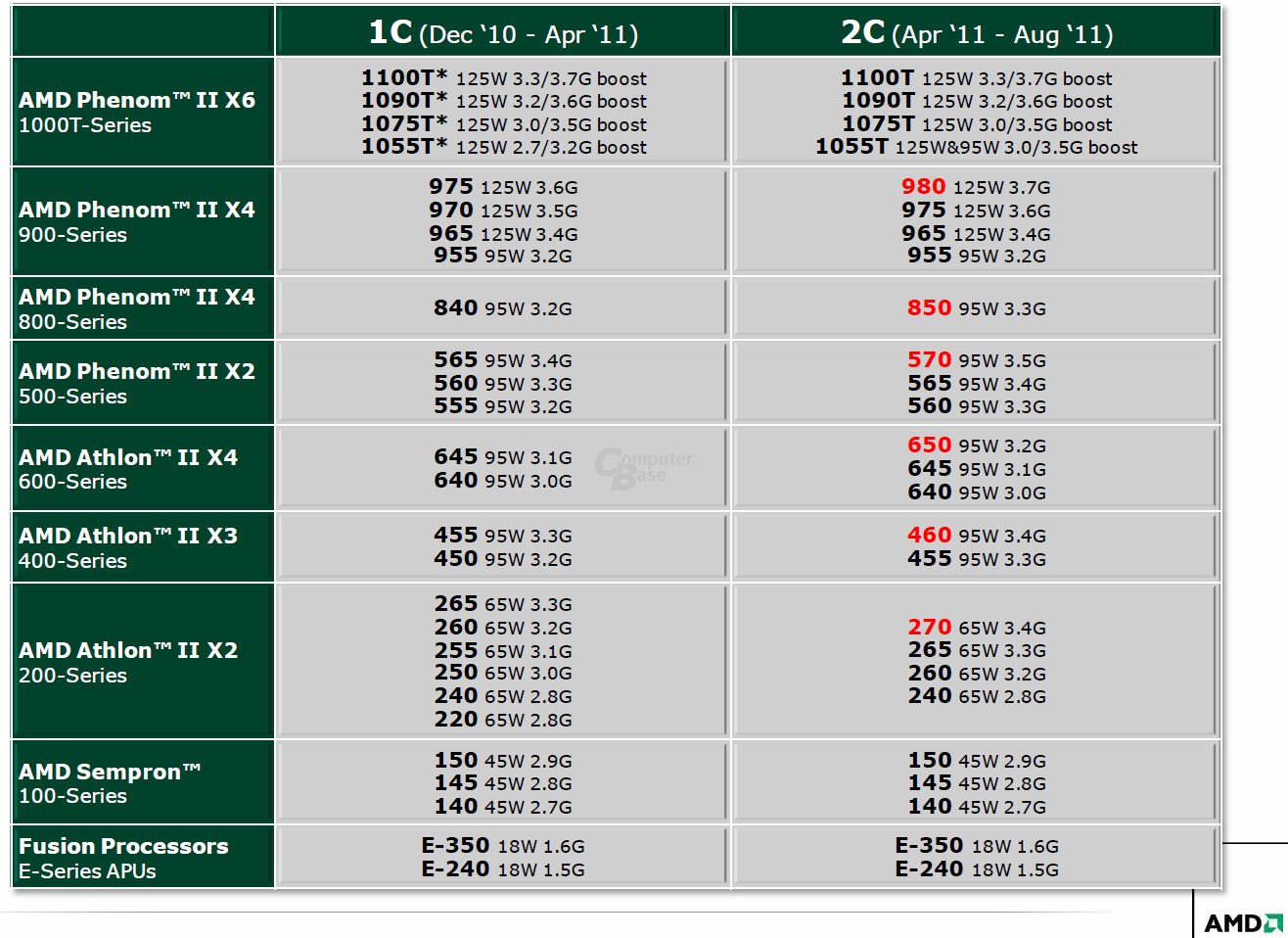 2 GHz
2 GHz  5 GHz
5 GHz Phenom II X2 Processors
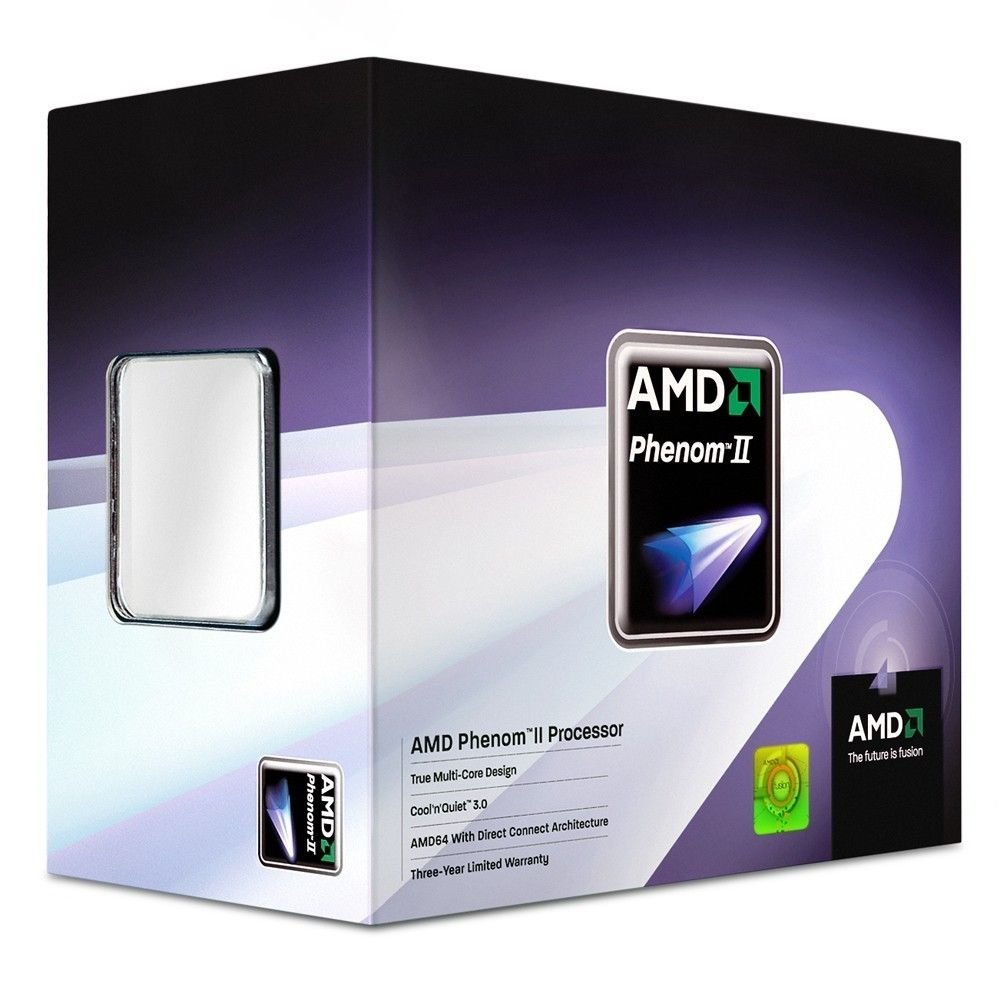 875 — 1.425
875 — 1.425 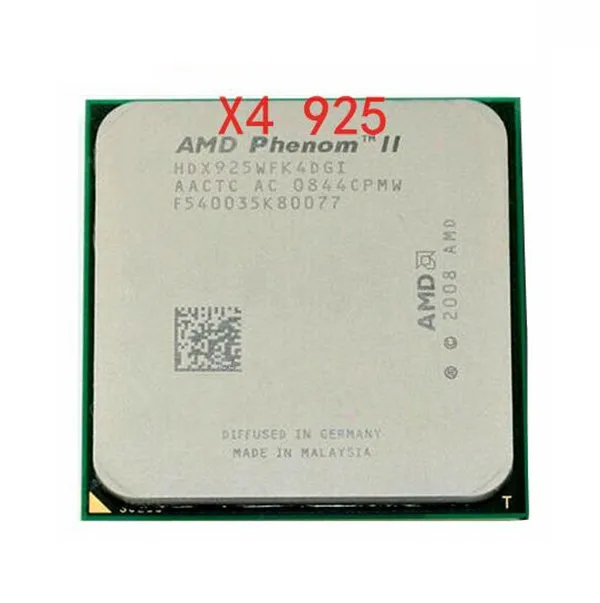 5x
5x Phenom II X3 processors
| Processor name | Stepping | Frequency | L2 cache | L3 cache | Hyper Transport Frequency | HT base frequency multiplier | Voltage | TDP | Socket |
| AMD Phenom II X3 700e | C2 | 2.4 GHz | 3x 512 KB | 6 MB | 2 GHz | 12x | 0.825 — 1.25 | 65W | AM3 |
| AMD Phenom II X3 705e | C2 | 2. 5 GHz 5 GHz |
3x 512 KB | 6 MB | 2 GHz | 12.5x | 0.800 — 1.25 | 65 W | AM3 |
| AMD Phenom II X3 710 | C2 | 2.6 GHz | 3x 512 KB | 6 MB | 2 GHz | 13x | 0.875 — 1.425 | 95W | AM3 |
| AMD Phenom II X3 715 | C2 | 2.8 GHz | 3x 512 KB | 6 MB | 2 GHz | 14x | 0.875 — 1.425 | 95W | AM2+ |
| AMD Phenom II X3 720 | C2 | 2.8 GHz | 3x 512 KB | 6 MB | 2 GHz | 14x | 0.875 — 1.425 | 95W | AM3 |
| AMD Phenom II X3 720 Black Edition | C2 | 2.8 GHz | 3x 512 KB | 6 MB | 2 GHz | 14x | 0.850 — 1.425 | 95W | AM3 |
| AMD Phenom II X3 740 Black Edition | C2 | 3. 0 GHz 0 GHz |
3x 512 KB | 6 MB | 2 GHz | 15x | 0.850 — 1.425 | 95W | AM3 |
Phenom II X4 9 processors0007
| Processor name | Stepping | Frequency | L2 cache | L3 cache | Hyper Transport Frequency | HT base frequency multiplier | Voltage | TDP | Socket |
| AMD Phenom II X4 805 | C2 | 2.5 GHz | 4x 512 KB | 4 MB | 2 GHz | 12.5x | 0.875 — 1.425 | 95W | AM3 |
| AMD Phenom II X4 810 | C2 | 2.6 GHz | 4x 512 KB | 4 MB | 2 GHz | 13x | 0.875 — 1.425 | 95W | AM3 |
| AMD Phenom II X4 820 | C2 | 2.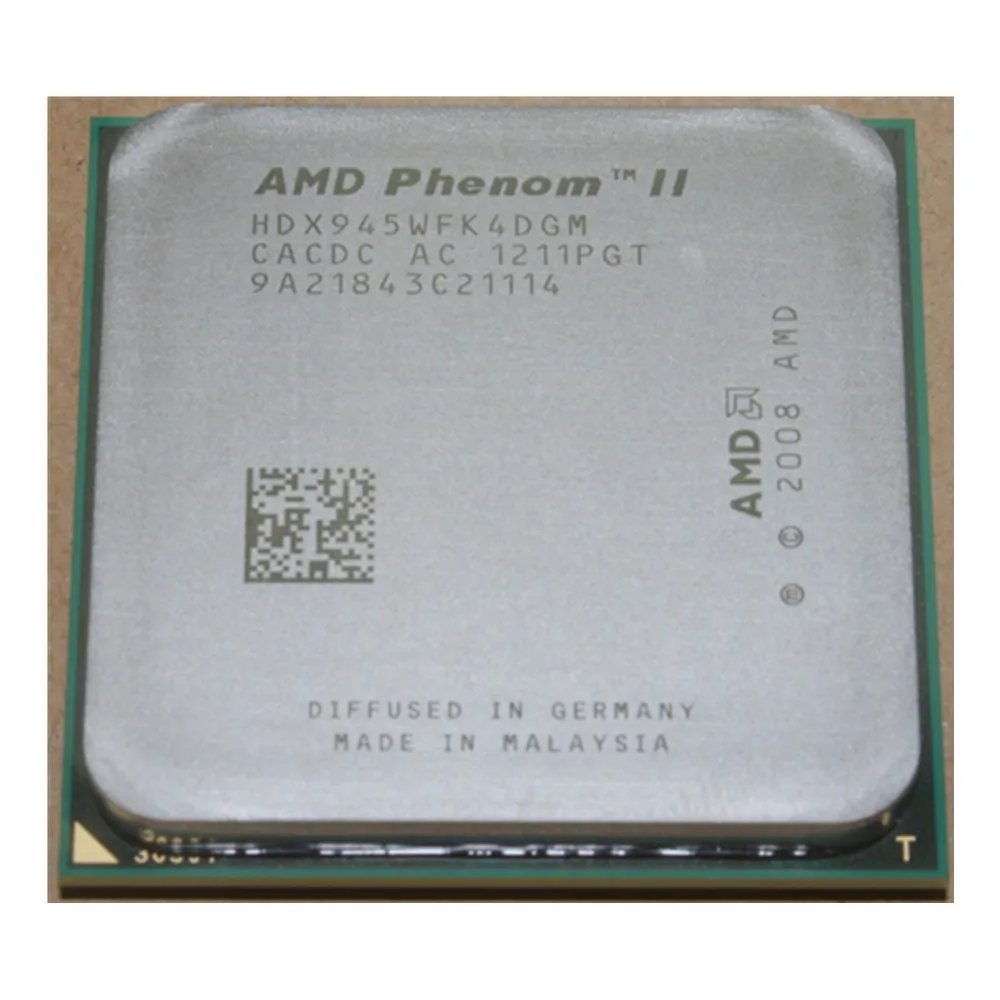 8 GHz 8 GHz |
4x 512 KB | 4 MB | 2 GHz | 14x | 0.9 — 1.425 | 95W | AM3 |
| AMD Phenom II X4 900e | C2 | 2.4 GHz | 4x 512 KB | 6 MB | 2 GHz | 12x | 0.850 — 1.250 | 65 W | AM3 |
| AMD Phenom II X4 905e | C2 | 2.5 GHz | 4x 512 KB | 6 MB | 2 GHz | 12.5x | 0.825 — 1.250 | 65 W | AM3 |
| AMD Phenom II X4 910 | C2 | 2.6 GHz | 4x 512 KB | 6 MB | 2 GHz | 13x | 0.875 — 1.425 | 95W | AM3 |
| AMD Phenom II X4 910e | C3 | 2.6 GHz | 4x 512 KB | 6 MB | 2 GHz | 13x | 0.850 — 1.250 | 65 W | AM3 |
| AMD Phenom II X4 920 | C2 | 2.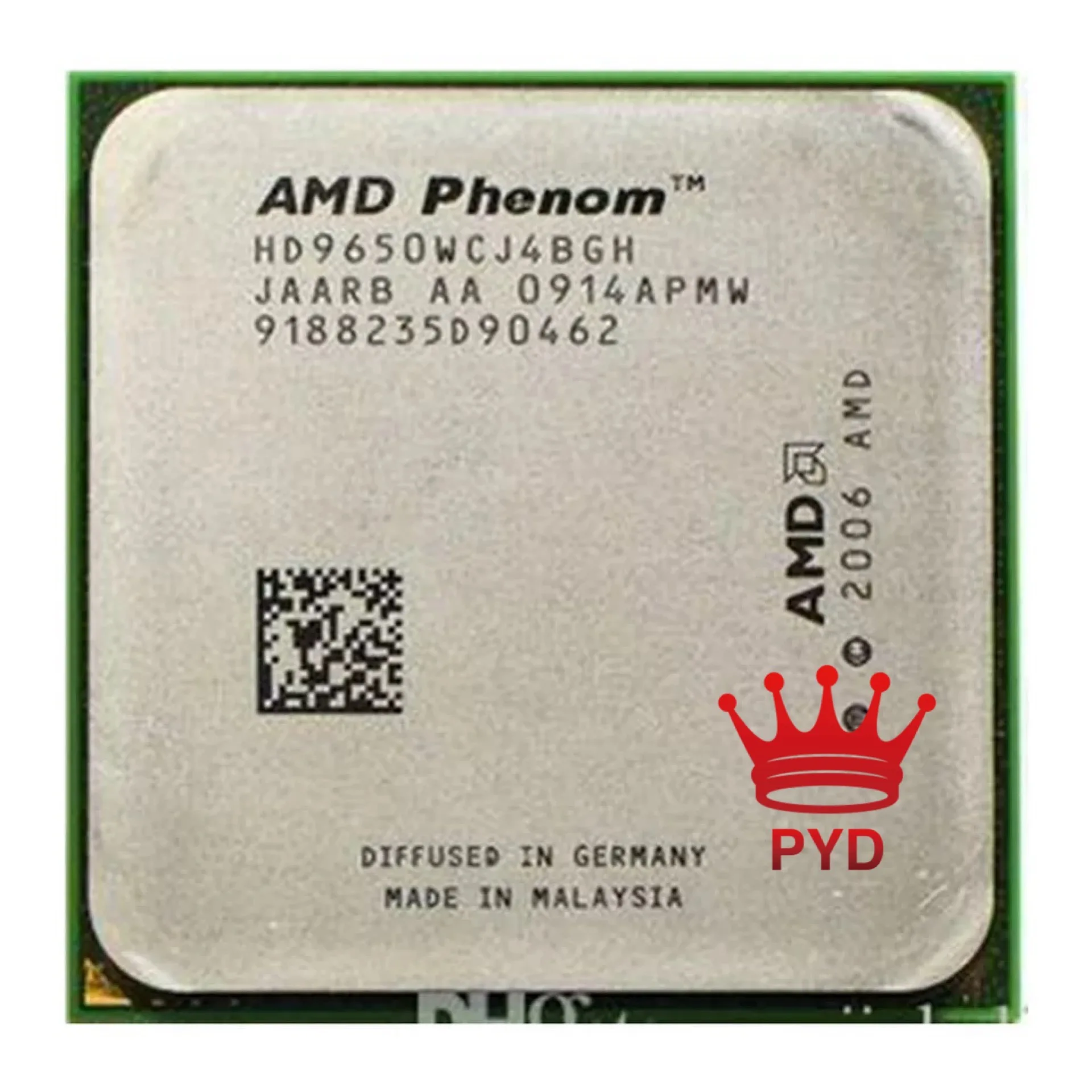 8 GHz 8 GHz |
4x 512 KB | 6 MB | 1.8 GHz | 14x | 0.875 — 1.425 | 125 W | AM2+ |
| AMD Phenom II X4 925 | C2 | 2.8 GHz | 4x 512 KB | 6 MB | 2 GHz | 14x | 0.850 — 1.425 | 95W | AM3 |
| AMD Phenom II X4 925 | C3 | 2.8 GHz | 4x 512 KB | 6 MB | 2 GHz | 14x | 0.9 — 1.400 | 95W | AM3 |
| AMD Phenom II X4 940 Black Edition | C2 | 3.0 GHz | 4x 512 KB | 6 MB | 1.8 GHz | 15x | 0.875 — 1.425 | 125 W | AM2+ |
| AMD Phenom II X4 945 | C2 | 3.0 GHz | 4x 512 KB | 6 MB | 2 GHz | 15x | 0.875 — 1.425 | 125 W | AM3 |
| AMD Phenom II X4 945 | C3 | 3. 0 GHz 0 GHz |
4x 512 KB | 6 MB | 2 GHz | 15x | 0.850 — 1.400 | 95W | AM3 |
| AMD Phenom II X4 955 | C2 | 3.2 GHz | 4x 512 KB | 6 MB | 2 GHz | 16x | 0.850 — 1.400 | 125 W | AM3 |
| AMD Phenom II X4 955 | C3 | 3.2 GHz | 4x 512 KB | 6 MB | 2 GHz | 16x | 0.850 — 1.400 | 125 W | AM3 |
| AMD Phenom II X4 955 Black Edition | C2 | 3.2 GHz | 4x 512 KB | 6 MB | 2 GHz | 16x | 0.875 — 1.425 | 125 W | AM3 |
| AMD Phenom II X4 955 Black Edition | C3 | 3.2 GHz | 4x 512 KB | 6 MB | 2 GHz | 16x | 0.825 — 1.425 | 125 W | AM3 |
| AMD Phenom II X4 965 Black Edition | C2 | 3.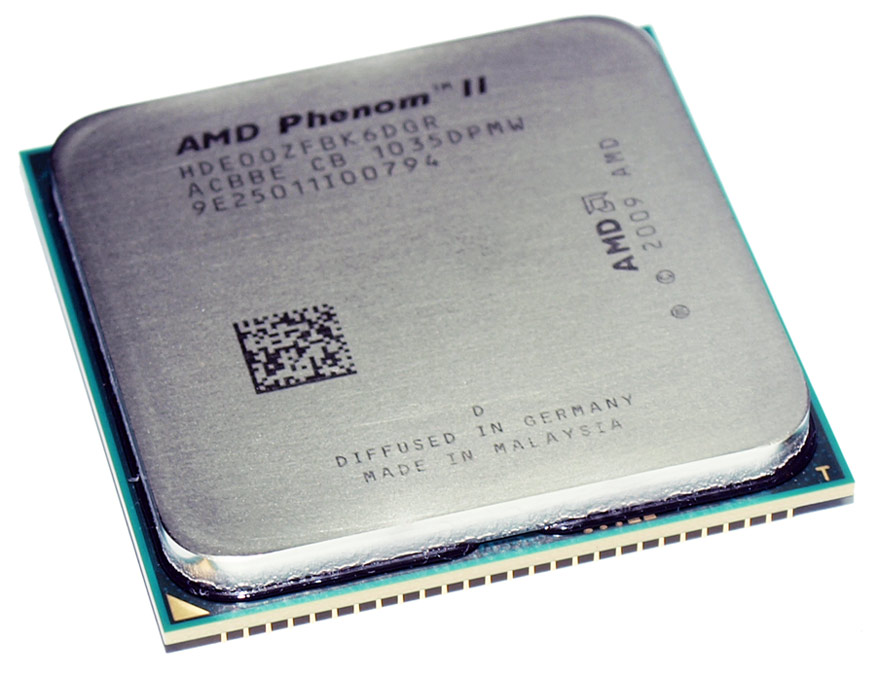 4GHz 4GHz |
4x 512 KB | 6 MB | 2 GHz | 17x | 0.850 — 1.425 | 140 W | AM3 |
| AMD Phenom II X4 965 Black Edition | C3 | 3.4GHz | 4x 512 KB | 6 MB | 2 GHz | 17x | 0.825 — 1.400 | 125 W | AM3 |
| AMD Phenom II X4 970 Black Edition | C3 | 3.5 GHz | 4x 512 KB | 6MB | 2 GHz | 17.5x | 0.825 — 1.400 | 125 W | AM3 |
| AMD Phenom II X4 975 Black Edition | C3 | 3.6 GHz | 4x 512 KB | 6 MB | 2 GHz | 18x | 0.825 — 1.400 | 125 W | AM3 |
| AMD Phenom II X4 980 Black Edition | C3 | 3.7GHz | 4x 512 KB | 6MB | 2GHz | 18.5x | 0.825 — 1.400 | 125W | AM3 |
Phenom II X6 processors
| Processor name | Stepping | Frequency | L2 cache | L3 cache | Hyper Transport Frequency | HT base frequency multiplier | Voltage | TDP | Socket |
| AMD Phenom II X6 1035T | E0 | 2.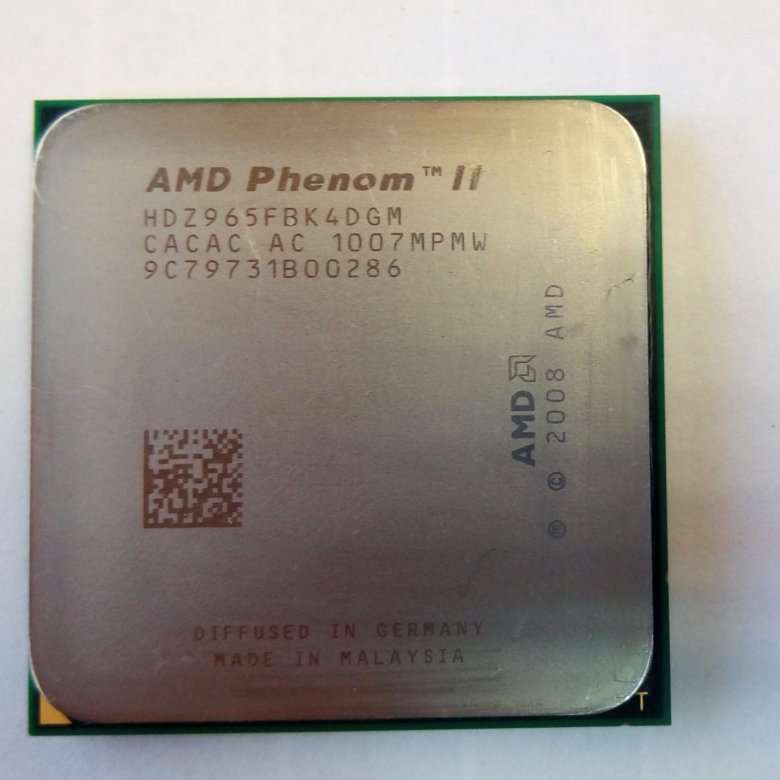 6 GHz 6 GHz |
6x 512 KB | 6MB | 2.0 GHz | 13x | 1.075 — 1.375 | 95W | AM3 |
| AMD Phenom II X6 1045T | E0 | 2.7GHz | 6x 512 KB | 6 MB | 2.0 GHz | 13.5x | 1.075 — 1.375 | 95W | AM3 |
| AMD Phenom II X6 1055T | E0 | 2.8 GHz | 6x 512 KB | 6 MB | 2.0 GHz | 14x | 1.125 — 1.400 | 125W | AM3 |
| AMD Phenom II X6 1075T | E0 | 3.0 GHz | 6x 512 KB | 6 MB | 2.0 GHz | 15x | 1.125 — 1.400 | 125W | AM3 |
| AMD Phenom II X6 1090T Black Edition | E0 | 3.2 GHz | 6x 512 KB | 6 MB | 2.0 GHz | 16x | 1.125 — 1.400 | 125W | AM3 |
| AMD Phenom II X6 1100T Black Edition | E0 | 3.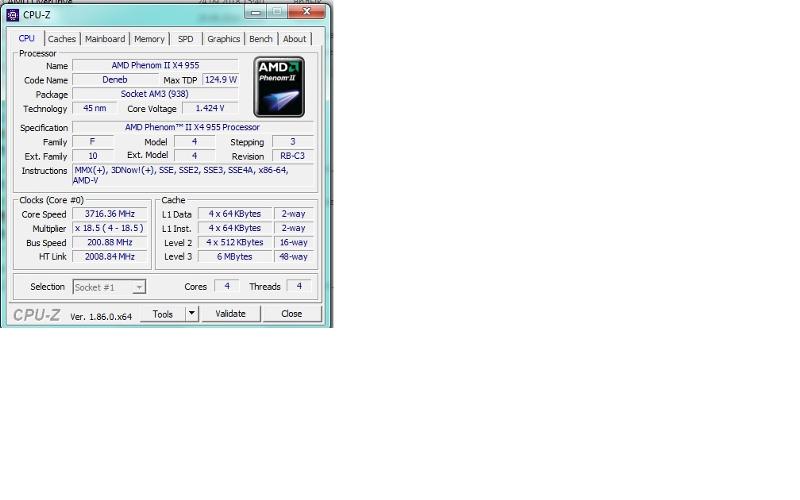 3GHz 3GHz |
6x 512 KB | 6 MB | 2.0 GHz | 16.5x | 1.125 — 1.400 | 125W | AM3 |
Mobile Phenom II processors 7
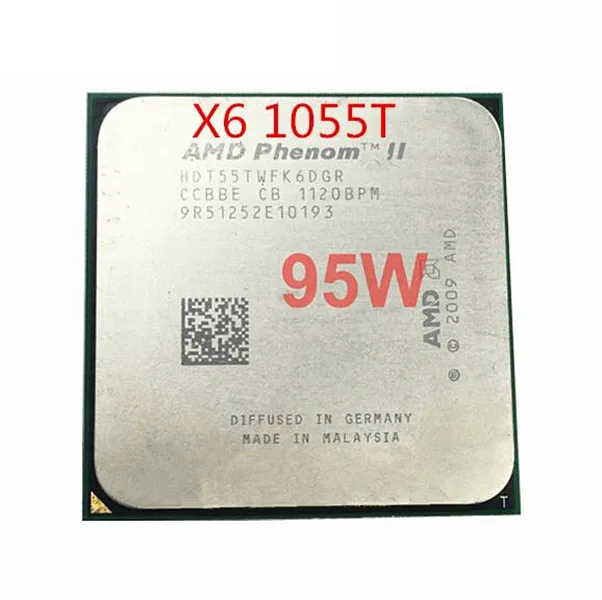 0 GHz
0 GHz  7 GHz
7 GHz Leave a comment
debut of Phenom II X4 processors / Processors and memory
Authors: Vladimir Romanchenko, Dmitry Sofronov
Just at CES 2009 in Las Vegas, AMD officially announced a new desktop hardware and software platform — AMD Dragon , and along with this, the first new generation desktop processors — AMD Phenom II X4 .
Today we present to our readers a complete review of Dragon platform technology and AMD Phenom II X4 processors. The review consists of two main parts. In Part 1, we will introduce you to the new platform features, the architectural enhancements of the new AMD Phenom II X4 processors, compare today’s innovations with the previous generation of AMD technologies, and provide new product specifications.
The review consists of two main parts. In Part 1, we will introduce you to the new platform features, the architectural enhancements of the new AMD Phenom II X4 processors, compare today’s innovations with the previous generation of AMD technologies, and provide new product specifications.
In the second part, we will present to your attention detailed studies of the new platform, comparing its capabilities with the flagship of the previous generation of AMD and with modern Intel platforms.
AMD Dragon Platform
Today’s AMD Dragon platform replaces the AMD Spider platform announced in November 2007, detailed in our article AMD Spider: Phenom Processors, 7-Series Chipsets and More. It was then that the new AMD Phenom processor brand was first announced, it was then that we learned about the hitherto current line of Series 7 logic sets, which, among other things, includes the flagship AMD 790FX chipset.
First of all, it is worth emphasizing that in full analogy with the AMD Spider platform technology, the new AMD Dragon desktop platform is also positioned as a system for enthusiasts.
From now on, Dragon is the most productive platform based on AMD components. A little later, in the second half of 2009, AMD business systems will move to the new Kodiak DDR3/AM3 platform; DDR3/AM3 platforms AMD Maui and AMD Pisces will be offered for consumer PCs (however, Dragon will be replaced by DDR3/AM3 platform Leo by that time).
During its existence, the AMD Spider platform technology has by no means remained in a mothballed form. So, new 65-nm multi-core AMD Phenom processors, including 4-core ones, for the Socket AM2+ processor socket appeared in succession; graphics chips of the ATI Radeon HD 3800 family gradually evolved to the modern Radeon HD 4800 series; but only
AMD 7 Series chipsets remain relevant to this day. The Spider platform natively supported technologies such as CrossFireX, AMD OverDrive, Microsoft DirectX 10.1, ATI PowerPlay, Cool’n’Quiet 2.0, HyperTransport 3.0 and PCI Express 2.0, full HD video.
AMD Dragon platform technology consists of three key elements — processors, chipsets and graphics cards.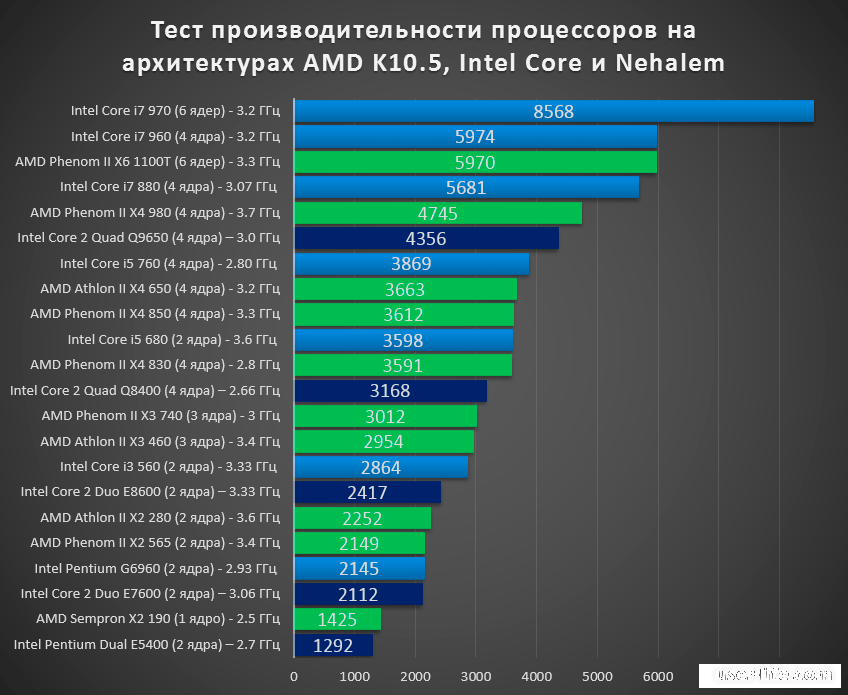 The key update, of course, is the new generation of 4-core AMD Phenom II X4 processors, made in compliance with the 45-nm process technology. For this reason, the architectural features of these processors will be discussed in more detail in this article a little lower.
The key update, of course, is the new generation of 4-core AMD Phenom II X4 processors, made in compliance with the 45-nm process technology. For this reason, the architectural features of these processors will be discussed in more detail in this article a little lower.
The chipsets are AMD 7 Series chipsets, completely inherited from the Spider platform. Moreover, it is these chipsets that will most likely appear in later platforms when processors for the AM3 socket with DDR3 memory support are introduced.
The AMD Dragon platform inherits the key features of the previous generation of Spider platform technology in an improved form and has acquired a number of new features.
Finally, the modern graphics of the Radeon HD 4800 family are also somewhat inherited from the Spider platform and will remain AMD’s highest performing graphics offering for desktop PCs for some time.
The totality of the capabilities of all platform components allows us to talk about the following innovations implemented in AMD Dragon:
- System optimization with AMD OverDrive 3.
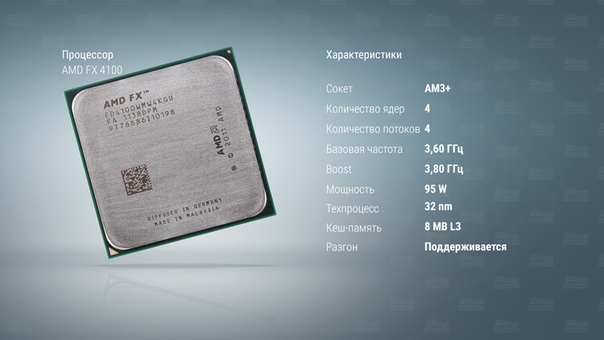 0 software
0 software
- AMD Phenom II X4 Processor Architectural Enhancements and 45nm Process Technology Allow for Flexible System Performance Tuning
- The Ultimate Visual Experience for HD Entertainment and Gaming — Supports the latest AMD graphics solutions including the Radeon HD 4870 X2 with 1600 stream processors, 2GB GDDR5 memory and up to 2.4 teraFLOPS performance for high-quality playback of Blu-ray and HD content video games
- Advanced anti-aliasing and anisotropic filtering — up to 24x CFAA (Custom Filter AA)
- DirectX 10.1 support
- ATI CrossFireX Technology
- ATI Avivo HD Technology
- PCI Express 2.0 Technology
However, in order to find out the key architectural features of the new AMD Dragon platform, it will be enough for us to familiarize ourselves in detail with the characteristics of the AMD Phenom II X4 family of processors and their differences from the previous processor architecture.
AMD Phenom II X4 processors
Unlike the previous generation of 65nm AMD Phenom (K10) processors, codenamed Agena, based on the common Barcelona microprocessor architecture, the new AMD Phenom II X4 (Deneb) processors are based on the new generation Shanghai microprocessor architecture with STARS extensions.
Today — at the time of the announcement of the new AMD Dragon platform, two new AMD Phenom II X4 processors for desktop systems are presented — with an index of 940 and 920.
The key characteristics of the AMD Phenom II X4 940/920 processors are in the table below. For your convenience, we’ve compared them to a couple of typical previous generation AMD Phenom processors.
|
Processor |
Phenom II X4 940 |
Phenom II X4 920 |
Phenom X4 9950 Black Edition |
Athlon X2 7750 Black Edtion |
| Process | 45nm SOI | 45 nm SOI | 65 nm SOI | 65 nm SOI |
Rev. |
Rev.RB-C2 | Rev.RB-C2 | Rev.B3 | Rev.B3 |
| Clock frequency | 3.0GHz | 2.8GHz | 2.6GHz | 2.7GHz |
| L1 Data Cache | 64KB x4 | 64 kb x4 | 64 kb x4 | 64 KB x 2 |
| L1 instruction cache | 64 KB x4 | 64 KB x4 | 64 KB x4 | 64 KB x 2 |
| L2 cache | 512 KB x4 | 512 KB x4 | 512 KB x4 | 512 KB x2 |
| L3 Cache | 6 MB | 6 MB | 2 Mb | |
| Core supply voltage | 0.875 — 1.5 V | 0.875 — 1.5 V | 1.05 — 1.30 V | 1.2 — 1.25 V |
| Processor socket | ||||
| Maximum temperature | 62°C | 62°C | 64°C | 73°C |
| TDP (max) | 125 W | 125 W | 140 W | 95 W |
First impressions of the new processor architecture changes: new 45nm process technology; increased clock frequency with simultaneously decreased TDP; tripled L3 cache. Now let’s take a closer look at the innovations implemented in the new processors of the AMD Phenom II X4 family.
Now let’s take a closer look at the innovations implemented in the new processors of the AMD Phenom II X4 family.
Manufacturing process using 45nm and Silicon on Insulator (SOI) technology. Compared to AMD’s previous generation of 65nm SOI process technology, the new processors are manufactured using 45nm SOI process technology using liquid immersion lithography. Thanks to the use of a more precise process technology and a number of circuitry innovations, it was possible to reduce the thermal package of processors at higher clock frequencies, reduce processor power consumption in standby mode by about 35%.
Thanks to the use of a new 45-nm process technology, it was also possible to improve the geometric performance of processors. So, now the 758 million transistors that make up the AMD Phenom II X4 family of processors are placed on a chip area of only 258 mm².
Increase L3 cache to 6 MB (Previous generation — 2 MB). In the new processors, the L2 cache is 512 KB x 4 for 4-core processors and 512 KB x 3 for 3-core processors; L1 cache (data + instructions) — 64 KB + 64 KB per core.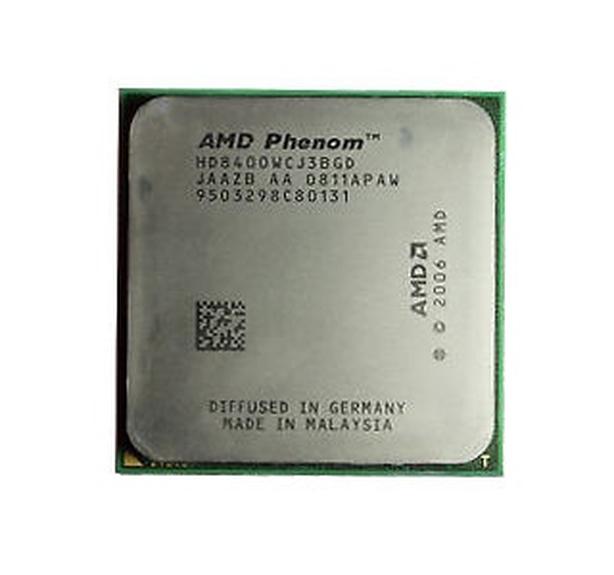 Thus, we get a combination of L1/L2 caches with a tripled distributed L3 cache. This organization of the cache memory can significantly reduce the latency when accessing the L2 cache while maintaining fast access to the L3 cache. The innovation should affect the overall performance of the processor due to a noticeable improvement in multi-threaded and multi-tasking applications, since each core has its own L2 cache and can access a large distributed L3 cache.
Thus, we get a combination of L1/L2 caches with a tripled distributed L3 cache. This organization of the cache memory can significantly reduce the latency when accessing the L2 cache while maintaining fast access to the L3 cache. The innovation should affect the overall performance of the processor due to a noticeable improvement in multi-threaded and multi-tasking applications, since each core has its own L2 cache and can access a large distributed L3 cache.
Built-in dual-channel DDR2 memory controller up to 17.1 Gb/s supports memory modules: PC2 8500 (DDR2-1066), PC2 6400 (DDR2-800), PC2 5300 (DDR2-667), PC2 4200 (DDR2- 533), PC2 3200 (DDR2-400) unbuffered.
The «unlocked» multiplier of the AMD Phenom II X4 940 Black Edition processor, when working together with the corresponding motherboards, allows you to change the multiplier and experiment with the speed and load characteristics of the system in a wide range.
Cool’n’Quiet 3.0 technology, combined with the energy-efficient 45nm design of the AMD Phenom II X4 processors, provides significant power savings. According to AMD’s official statements, the new version of the power-saving technology is 50% more efficient than the previous version of Cool’n’Quiet 2.0.
According to AMD’s official statements, the new version of the power-saving technology is 50% more efficient than the previous version of Cool’n’Quiet 2.0.
Compatibility . AMD Phenom II X4 processors use the same infrastructure as the previous generation of AMD Phenom X4 processors, the same 940-pin micro Pin Grid Array (microPGA) Socket AM2+ processor. This makes it easy to upgrade an existing system: to work with AMD Phenom II X4 chips, most likely you just need to download a new BIOS for your existing motherboard and check if this board supports processors with a TDP of 125W.
Smart Fetch technology due to the intelligent adjustment of cache load volume allows in some modes to reduce the total power consumption of L1/L2/L3 caches up to 21%.
HyperTransport 3.0 technology , familiar to us from the previous architecture, also works in the new AMD Phenom II X4 processors. This architecture also implements the AMD64 with Direct Connect architecture, well known from the previous designs.
From the point of view of the internal circuitry of the new microarchitecture, it should be noted that the 4-core Phenom II X4 processors completely and almost unchanged (without radical changes) inherited the entire list of STARS architectural improvements first implemented in the Barcelona (Agena) architecture. This applies to a 128-bit memory controller supporting up to DDR2-1066 with the ability to operate in 2-channel 64-bit mode to independently perform memory write and read operations; the physical address space at the same time increased to 48 bits, and memory support up to 256 TB.
This includes the Wide Floating Point Accelerator, which supports 36 new 128-bit operations, and support for 128-bit SSE operations in addition to the capabilities of the previous 64-bit architecture. The processors are also capable of processing up to two SSEs and one SSE transfer per clock.
The Phenom II X4’s instruction fetch buffer has a 32-byte structure, and the branch prediction module has 512-way indirect branch prediction. The performance of the data cache has been increased from one 64-bit load per clock to one 128-bit load per clock, and the performance of the L2 data cache — memory controller has been increased to 128-bit load per clock.
The performance of the data cache has been increased from one 64-bit load per clock to one 128-bit load per clock, and the performance of the L2 data cache — memory controller has been increased to 128-bit load per clock.
Also, the new processors support AMD Virtualization Technology with Rapid Page Indexing, and support for dynamic clock control for each core.
In conclusion, moving on to purely applied aspects of today’s announcement, that is, to testing a real system based on the Phenom II X4 processor, I would like to mention AMD’s policy of positioning the new Dragon platform by AMD.
As in the previous case of Spider, AMD focuses on the availability of its platform. For example, official documents mention the wholesale price of the Phenom II X4 9 processor40 at $275, and this factor, along with the affordable cost of the rest of the platform components, is presented as a significant advantage over competitors. In other words, even if in some applications the processor of the Phenom II X4 processor does not have enough performance for champion laurels, AMD «hints» at comparing the price tags of chips with similar performance.
Well, when summing up the results, we will definitely take into account these tactful hints.
How and what we tested
During testing, we compared four different platforms — two on AMD processors, including an AMD Phenom II X4 940 system, and two on Intel processors. It is these systems that seemed to us the most indicative for assessing the typical capabilities of modern configurations of desktop PCs of a productive class.
|
Processor |
AMD Phenom X4 9950 |
AMD Phenom II X4 940 |
Intel Core 2 Quad 9300 |
Intel Core i7 965 Extreme |
| L1 Cache, KB | 4 x 128 | 4 x 128 | 4 x 64 | 4 x 128 |
| L2 cache, KB | 4 x 512 | 4 x 512 | 2 x 3072 | 4 x 256 |
| L3 Cache, MB | 2 | 6 | — | 8 90 039 |
| Process technology, nm | 65 | 45 | 45 | 45 |
| HT speed, MHz | 4000 | 3600 | — | — |
| FSB, MHz | 200 | 200 | 1333 | 133 |
| 00 | ||||
| Intel QuickPath Interconnect | — | — | — | 6.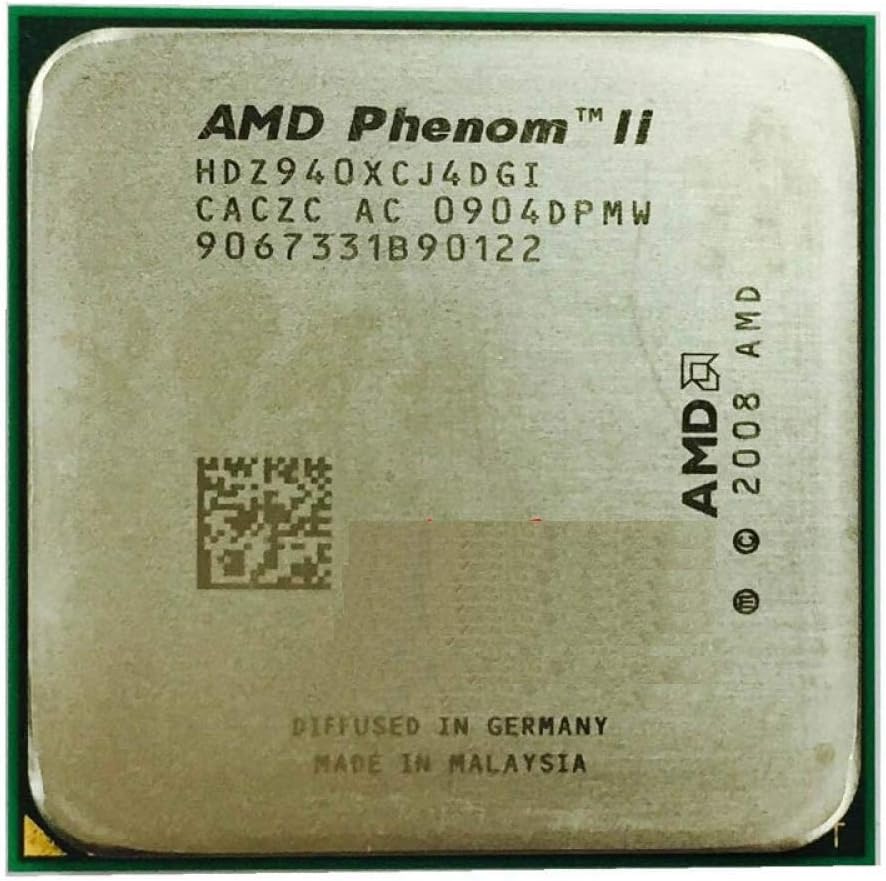 4 GT/s 4 GT/s |
| Test conditions | ||||
| Real processor frequency, MHz | 3000 (200×15) | 3000 (200×15) | 3000 (400×7.5) | 3060 (133×23) |
| Memory type/speed 3-1333 | ||||
| Motherboard | Gigabyte 790GP | Gigabyte 790GP | ASUS P5QC | Gigabyte EX58 |
| Video System | Radeon HD4870X2 | Radeon HD4870X2 | Radeon HD4870X2 | Radeon HD4870X2 |
| Operating system | WinVista Ultimate 32-bit | WinVista Ultimate 32-bit | Win Vista Ultimate 32-bit | WinVista Ultimate 32-bit |
Test results
To begin with, let’s get acquainted with the results of the CPU-Z utility, which determines the specifications and main performance characteristics of the processor, motherboard, and system memory.
The CPU-Z utility version 1. 49 (December 2008) absolutely correctly determines all the parameters of the AMD Phenom II X4 940 processor, including the working series name and socket. The revision of the processor stepping — RB-C2 — looks somewhat strange. Perhaps the most reliable assumption is that the letters RB (Re-Build?) marked the redesign of the Agena core, its transfer to the norms of the 45-nm process technology, as a result of which Deneb turned out.
49 (December 2008) absolutely correctly determines all the parameters of the AMD Phenom II X4 940 processor, including the working series name and socket. The revision of the processor stepping — RB-C2 — looks somewhat strange. Perhaps the most reliable assumption is that the letters RB (Re-Build?) marked the redesign of the Agena core, its transfer to the norms of the 45-nm process technology, as a result of which Deneb turned out.
Improvements in the technical process had a very positive effect on the overclocking potential of the new AMD processors, which they could not boast of lately, with difficulty overcoming the 3 GHz frequency bar. As you have already seen in our news, Phenom II processors are capable of overclocking above 4 GHz, with proper cooling. The sample that came to our laboratory, unfortunately, behaved somewhat unstable at 4 GHz, so to assess the scalability of Phenom II performance in terms of frequency, we decided to stop at 3.6 GHz, at which the processor behaved absolutely stable.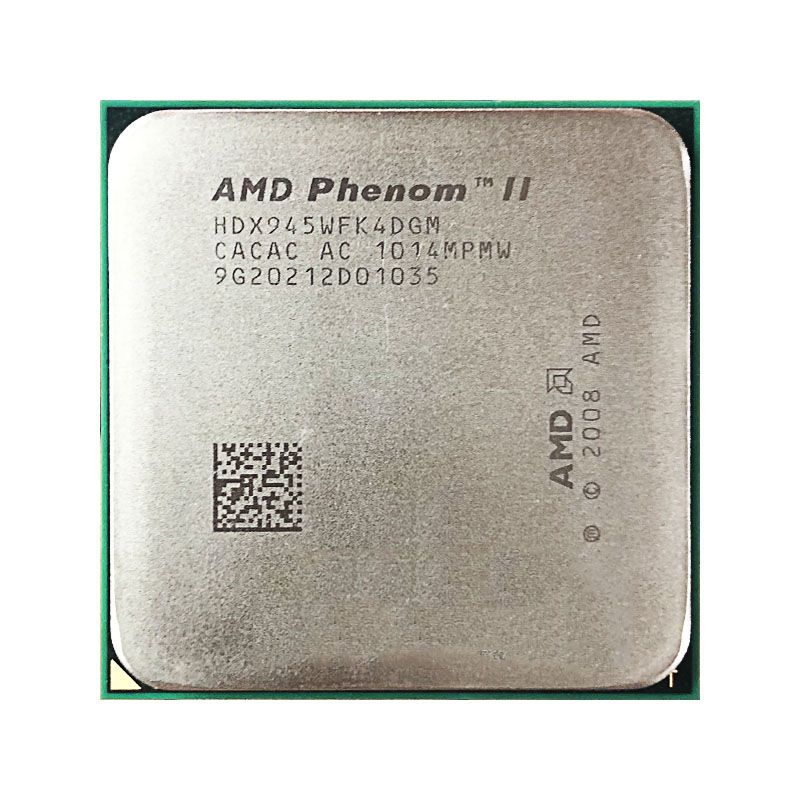 As for the increase in the core voltage, the processor easily withstood VCore up to 1.7 V (from the standard 1.35 V). However, we still have to study the intricacies of overclocking, and, quite possibly, the overclocking potential of our instance of the processor will be higher.
As for the increase in the core voltage, the processor easily withstood VCore up to 1.7 V (from the standard 1.35 V). However, we still have to study the intricacies of overclocking, and, quite possibly, the overclocking potential of our instance of the processor will be higher.
We test the test and control systems with the traditional Everest benchmark complex.
In this test, the results of the Phenom and Intel Core 2 Quad processors are almost the same, their difference does not exceed 3%. The undisputed leader is the Intel Core i7 965 Extreme, whose memory controller efficiency is unrivaled.
When writing to memory, the new Phenom shows a significant increase in speed compared to its predecessor — about 20%. However, this still does not allow it to get much closer to the results of the Intel Core 2 Quad, not to mention twice the results of the Intel Core i7 9.65 Extreme.
The superiority of the Intel Core i7 965 Extreme is still undeniable, but in the second division, the victory remains with AMD Phenom. Interestingly, here the overclocked Phenom showed slightly lower results than in normal mode. Intel Core 2 Quad looks like an obvious outsider here. However, one can complain about the test itself — if the read and write speeds do not exceed 8000 Mb / s, how can the copy speed be higher than 9000 Mb / s? Probably, this synthetic test does not take into account the presence of L3 cache memory in processors and works somewhat incorrectly.
Interestingly, here the overclocked Phenom showed slightly lower results than in normal mode. Intel Core 2 Quad looks like an obvious outsider here. However, one can complain about the test itself — if the read and write speeds do not exceed 8000 Mb / s, how can the copy speed be higher than 9000 Mb / s? Probably, this synthetic test does not take into account the presence of L3 cache memory in processors and works somewhat incorrectly.
The results of the RAM latency test are quite predictable. Thanks to the incredible efficiency of the integrated memory controller, the Intel Core i7 965 Extreme is in the lead. Behind it, the results of AMD Phenom processors are placed in a dense group, and the Intel Core 2 Quad processor, which is forced to communicate with the RAM through the chipset, closes the race.
In this test, we do not see any significant advantages of the Phenom II ALU over its predecessor. Overclocking to 3.6 GHz shows a good scalability of the Phenom II results, but even in this case, its results only compare with the results of the Intel Core 2 Quad running at 3. 0 GHz. Well, ahead of the rest, as usual — Intel Core i7 965 Extreme.
0 GHz. Well, ahead of the rest, as usual — Intel Core i7 965 Extreme.
In the Everest PhotoWorxx test, the new Phenom finally triumphs. The almost one and a half times advantage over its predecessor is most likely due to the significantly increased amount of third-level cache memory. Apparently, for the same reason (or rather, because of the lack of L3 cache memory), Intel Core 2 Quad lags far behind all other test participants. Well, ahead again is the Intel Core i7 965 Extreme, which has a three-channel memory controller with low latency and plenty of L3 cache.
In the Everest Z-lib test, the situation is similar to the previous one, except that the gap in the results is not so pronounced.
In this test, the advantage of the new Phenom compared to the «old» version is clearly visible, however, the results of the new product still almost fall short of the results of the Intel Core 2 Quad 9300 operating at the same frequency.
But in the Everest FPU Julia test, the situation changes dramatically.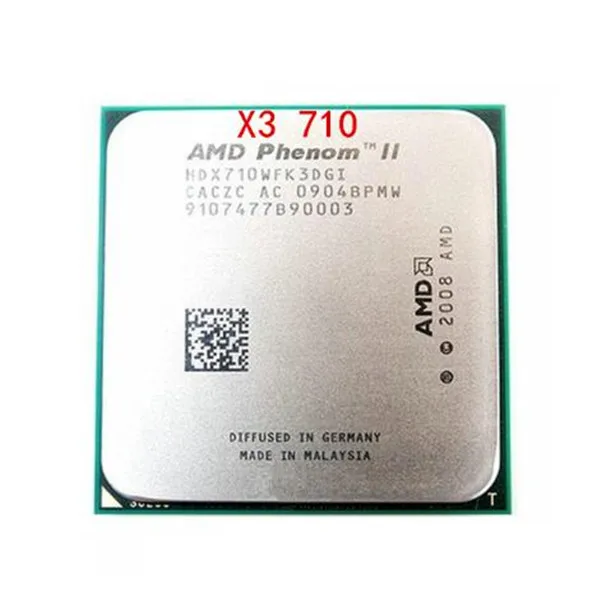 Phenom processors cannot compete with the powerful FPUs of Intel processors, and even overclocking does not save them from defeat.
Phenom processors cannot compete with the powerful FPUs of Intel processors, and even overclocking does not save them from defeat.
In the Everest FPU Mandel test, the Phenom processors again show close results and are slightly behind the Core 2 Quad 9300 running at the same frequency. However, due to good scalability during overclocking, the situation can be improved.
In the Everest FPU SinJulia test, the situation is similar to the previous one.
Now let’s move on to testing with the 3DMark Vantage synthetic package.
In 3DMark Vantage CPU tests, Intel processors take the lead. As for AMD processors, there is definitely some improvement in the results of the new generation Phenom. Let’s look at these tests in more detail.
This test is a set of various image conversion operations in the Paint.Net graphics package. The total test execution time is estimated, respectively, the smaller it is, the better the result. As you can see, it’s hard for AMD processors to compete with Intel processors here, although the second generation of Phenom shows slightly better results compared to the first.
As you can see, it’s hard for AMD processors to compete with Intel processors here, although the second generation of Phenom shows slightly better results compared to the first.
In the built-in WinRar performance test, AMD processors, on the contrary, show quite remarkable results and confidently overtake Core 2 Quad 9300 at the same clock frequency. Apparently, the built-in memory controller and the presence of a large amount of third-level cache memory are affecting. For the same reasons, the results of the Intel Core i7 965 Extreme processor fly into sky-high heights.
However, in Cinebench’s CPU benchmarks, which involve rendering images by the CPU, FPU performance is more important. For this reason, Intel processors are once again out of reach.
And finally, CPU tests in Crysis. Testing was carried out at a screen resolution of 1024×768 pixels without full-screen anti-aliasing and anisotropic filtering, so that the influence of the video card is as minimal as possible. Nevertheless, we ran the tests in all four main graphics quality modes — Low, Medium, High and VeryHigh, since increasing the «severity» of the graphics mode turns on the «destructibility» of objects in the game and, thereby, leads to an increase in CPU load in terms of calculation of «physics».
Nevertheless, we ran the tests in all four main graphics quality modes — Low, Medium, High and VeryHigh, since increasing the «severity» of the graphics mode turns on the «destructibility» of objects in the game and, thereby, leads to an increase in CPU load in terms of calculation of «physics».
As you can see from the diagram, with the graphics quality settings «Low», the results of Intel processors are ahead. In more «heavy» graphics modes, the difference in results decreases sharply. However, it can be noted that the Phenom II feels more confident than its predecessor running at the same frequency. And even more than that — it is able to overtake Core 2 Quad 9300 at equal frequencies.
Totals
So, the debut of the new Phenom II X4 processors can be called successful, and the mass transition of AMD’s processor technology to the standards of the new 45-nm process technology has taken place. In this regard, the pancake was by no means lumpy.
In most test disciplines, the new «desktop» flagship Phenom II X4 940 compared to the previous generation of AMD processors shows decent results even without additional overclocking. In general, the new AMD Dragon platform can be called an accomplished and quite competitive solution.
And yet, the new generation of Phenom II X4 processors is still lagging behind the competitors of the Intel Core i7 family. Analyzing the above test results, especially in terms of the performance of the memory subsystem, one can conclude that despite the attractiveness of using the integrated memory controller model, this alone cannot achieve superiority. The competitor also switched to using an integrated memory controller, but combined this with a move to more scalable DDR3 memory.
Taking into account the fact that in the second half of 2009Since Deneb core processors are planning to get DDR3 support, we have a chance to see some additional performance improvement of AMD processors. In addition, it should be taken into account that by this time the Deneb core will have time to change several steppings, which, most likely, will contain an element of «tuning» the chip circuitry, or, if you like, «fixing bugs».